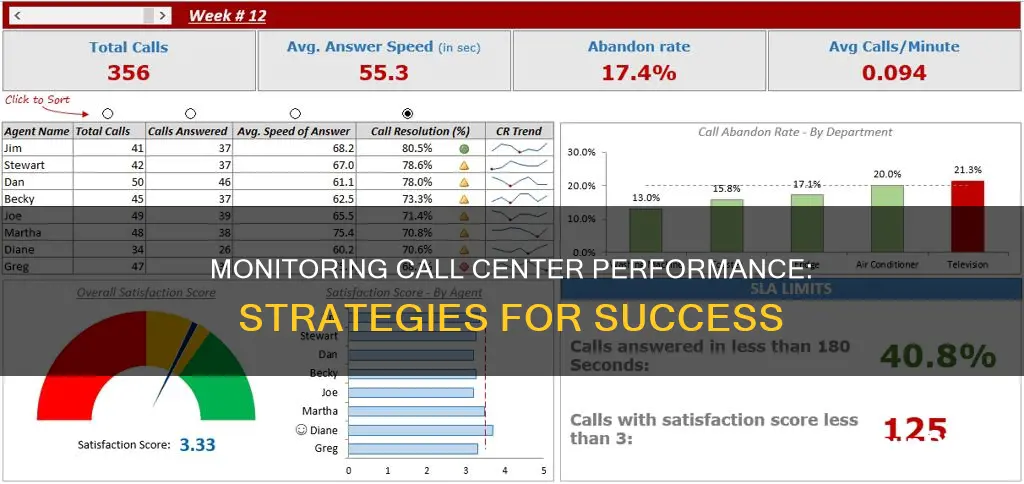
Call centre performance can be monitored through a variety of metrics and key performance indicators (KPIs). These can be used to assess the effectiveness of customer service teams and improve customer satisfaction.
Call centres use a broad set of KPIs, which can be measured at the department, team and agent level. These include customer satisfaction, handle time, call volume, and costs. By using these metrics, call centre staff can maximise their productivity and effectiveness, ultimately reducing costs.
What You'll Learn

Average Handle Time
AHT is calculated using the following formula:
> AHT = (Total Talk Time + Total Hold Time + Total After-Call Work Time) / Total Number of Calls
A good AHT is generally considered to be around 6 minutes, but this can vary depending on the industry and the nature of customer queries. For example, highly technical queries or those requiring multiple steps will naturally take longer to resolve.
While it's important to strive for efficiency and keep costs down, focusing solely on reducing AHT can be detrimental. Call centres should also prioritise the quality of customer service and ensure that agents are not rushing customers off the phone, which can lead to a poor experience.
To improve AHT, call centres can take several steps:
- Understand the context of calls and the appropriateness of agent responses, taking into account the nature and complexity of the issue.
- Reduce unnecessary waits or silences during the call, improving the flow of the conversation.
- Enhance agent training with continuous programmes that cover a range of scenarios.
- Improve the logistics of calls, such as optimising call transfers and recording calls for analysis.
- Monitor team performance and streamline interdepartmental workflows to improve internal communication.
By tracking AHT and taking steps to optimise it, call centres can improve customer satisfaction, increase productivity, and reduce costs.
Is Your WiFi Being Monitored? Here's How to Tell
You may want to see also

Customer Satisfaction
There are several ways to measure customer satisfaction:
- Net Promoter Score (NPS): This is a powerful metric used to gauge customer loyalty and satisfaction. It is calculated by asking customers how likely they are to recommend the company to a friend or colleague on a scale of 0-10. Customers who respond with a score of 9-10 are considered promoters, 7-8 are passives, and 0-6 are detractors. The NPS is then calculated by subtracting the percentage of detractors from the percentage of promoters, with a maximum score of 100.
- Customer Satisfaction Score (CSAT): This provides insight into the average customer experience and satisfaction rates with customer support or services. Companies typically ask for feedback on whether the customer's issue was resolved or their needs were met. Responses are then categorized into sentiments such as very satisfied, satisfied, or unsatisfied, and a score is calculated.
- Customer Effort Score (CES): This measures the amount of effort a customer has to put in to resolve an issue. A survey is deployed at the end of a call, asking the customer to rate how easy it was to handle their issue, typically on a scale of 1-7. A high CES indicates superior service quality and ease of getting support.
To improve customer satisfaction, call centers can:
- Focus on customers' explanations for their NPS rating to understand what is causing satisfaction or dissatisfaction.
- Make it easier for customers to connect with agents by offering contact options beyond phone calls, such as live chat, email, and messaging.
- Provide self-service resources, such as an FAQ page, knowledge base, or chatbots, to empower customers to solve basic issues on their own.
- Train agents on how to resolve customer issues more effectively and encourage the use of self-service options.
- Improve agent utilization rate by ensuring agents are spending their time efficiently and productively.
- Reduce wait times by optimizing interactive voice response (IVR) menus, boosting agent staffing during peak periods, and keeping callers informed.
- Implement advanced call routing to direct customers to the most appropriate agent or department.
- Monitor and analyze call center metrics to identify areas that need improvement.
- Listen to customer feedback and implement regular surveys to understand satisfaction levels.
Backlight Basics: Understanding LED's Role in LCD Monitors
You may want to see also

First Call Resolution
FCR is calculated by taking the total number of customer cases resolved on the first try, dividing it by the total number of cases in a given period, and then multiplying by 100 to get a percentage. For example, if a call center received 400 calls in a day and resolved 280 of those cases on the first try, the FCR for that day would be 70%.
The call center industry benchmark for FCR is just under 70%, with world-class performance considered to be 80% and above. However, it's important to note that FCR rates can vary by industry, with more complex fields such as tech support having lower rates than less complex ones like retail.
Improving FCR can have a positive impact on customer satisfaction, employee satisfaction, operating costs, and the company's bottom line. Here are some strategies to improve FCR:
- Set realistic goals and track performance across all channels, not just phone calls.
- Train agents and provide continuous learning opportunities to enhance their skills and knowledge.
- Implement incentive programs to motivate agents to resolve issues efficiently and effectively.
- Leverage technology, such as conversation analytics, to identify repeat calls and underlying issues affecting FCR.
- Respond to customer inquiries promptly and actively listen to their needs.
- Provide robust self-service options, such as FAQs and knowledge bases, to empower customers to resolve simpler issues on their own.
- Measure FCR performance regularly and use the data to set goals, improve training, and optimize the overall call center process.
Freesync Monitors: Why Nvidia Users Should Consider the Switch
You may want to see also

Average Speed of Answer
ASA is important because it gives call centre staff an understanding of the customer experience and the tools to improve it. Customers value their time, so a low ASA is preferable as it means agents are answering calls quickly and efficiently.
The ASA formula is:
> ASA = Total Wait Time of All Answered Calls / Total Number of Answered Calls
The global average ASA is 28 seconds, and the 80/20 rule (80% of calls answered within 20 seconds) is often cited as the benchmark. However, there is a lot of variety between different centres, and customers will tolerate different waiting times depending on the type of service. For example, customers calling technical assistance lines will usually wait longer than those calling conventional service lines.
ASA is often included in a contact centre's Service Level Agreement (SLA), guaranteeing that a certain volume of calls will be answered within an agreed time.
To improve ASA, you can:
- Use an in-queue callback option so customers can opt for a return call rather than waiting in the queue
- Forecast and monitor call volume to ensure adequate staffing levels at busy times
- Make use of an effective call routing system and IVR menu to direct customers to the right place
- Train and retrain agents to ensure they are equipped to deal with queries efficiently
- Give agents access to real-time analytics so they can identify any issues with their performance and address them
- Reward agents who consistently meet or exceed benchmarks to boost morale and motivate others
Battery Size for Elfi Doggy Monitor: All You Need to Know
You may want to see also

Call Abandonment Rate
A high call abandonment rate indicates that many people are ending calls without having their issue resolved, which can lead to poor customer satisfaction scores and negative consequences for the business. Therefore, it is important to strive for lower call abandonment rates to ensure customers' issues are addressed and they remain satisfied.
The formula for calculating call abandonment rate is:
For example, if a call center received 300 calls in a month and handled 280 of them, the abandonment rate would be approximately 6.7%.
The industry benchmark for an acceptable call abandonment rate is around 5-12%, although this may vary by industry and some sources suggest aiming for below 3-5%.
To improve call abandonment rates, call centers can:
- Automate repetitive tasks to save time for service teams.
- Adopt a customer-in strategy, focusing on the customer's needs during each handoff rather than a function-out model.
- Implement a call-back feature, so customers don't have to wait on hold.
- Ensure adequate staffing during peak call times.
Removing Ankle GPS Monitors: A Step-by-Step Guide
You may want to see also
Frequently asked questions
KPIs are used to measure a call center's performance and efficiency. Some common KPIs include:
- Average call abandonment rate
- Percentage of calls blocked
- Average time in queue
- Average speed of answer
- Average handle time
- First call resolution
- Customer satisfaction score
- Net promoter score
- Agent utilization rate
- Average call length
AHT measures the average time taken by an agent to complete a single interaction, including talk time, hold time, and after-call work. A lower AHT indicates higher efficiency, but focusing solely on AHT may compromise the quality of service.
FCR measures the percentage of calls where the agent resolves the caller's issue without requiring a callback, transfer, or escalation. A high FCR rate indicates excellent call quality and customer satisfaction.
NPS is a metric used to gauge customer loyalty and satisfaction. It asks customers how likely they are to recommend the company to others on a scale of 0-10. The score categorizes customers into promoters, passives, and detractors, providing insights into their satisfaction.
Here are some tips to improve call center performance:
- Use software to enhance call quality and remove background noise.
- Invest in the right call center software for tracking metrics.
- Focus on agent development through coaching, training, and feedback.
- Listen to and act on agent feedback to improve their experience.
- Avoid obsessing over metrics at the cost of quality service.







